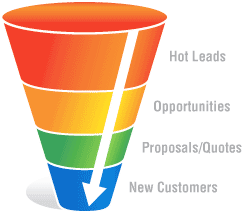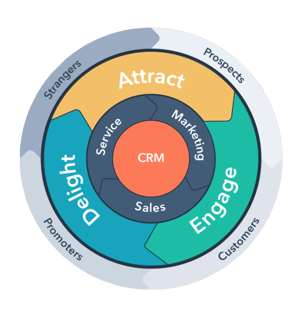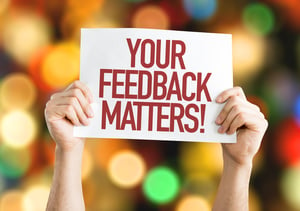Does My Business Need A Local SEO Agency?
If potential clients in your community can’t find you online, you are likely doing something wrong or doing nothing at all to get found.

Consumers are more informed and empowered than ever, which is why it’s critical for your business to have a system in place that opens the gates for them to find you.
By now, you’ve likely heard that building a successful lead generation strategy involves creating a digital marketing funnel, or sales funnel, that better allows you to nurture and qualify your leads before handing them off to sales. A successful funnel system gives you the opportunity to nurture leads through each stage of the buyers’ journey, so they eventually become a customer.

But, what does a digital marketing funnel look like, and what does it do for your business?
You may be surprised to find out that your digital marketing funnel shouldn’t be a funnel at all. Your funnel should instead look like a flywheel. Here’s why.
Because the traditional sales funnel places customers as the output, many inbound marketing agencies now use the flywheel.
The flywheel incorporates the same components as a sales funnel but instead puts customers at the center. This creates a less linear approach to your lead generation activities.
The flywheel model is also more comprehensive and represents the fact that each action taken by a team member impacts another action. While the funnel is a good representation of how buyers learn about products, it doesn’t take into consideration that times have changed, and people are making decisions differently. For example, potential clients now rely on third-party advice, whether it’s from review sites, friends or mentions of your service on social media.
Funnels also don’t incorporate any momentum you build and reflect when your lead generation strategies start to experience a slowdown. Improving your internal processes will make your flywheel spin faster.
So what does a flywheel look represent? It incorporates three main components much like the funnel: Attract, engage and delight.

The Attract stage of the flywheel focuses on “drawing in the right people with valuable content and conversations that establish you as a trusted advisor with whom they want to engage,” according to Hubspot.
In this phase, you are looking to attract the right traffic to your company website. To determine who that “right traffic” is, you want to take a closer look at who your buyer personas are.
What is a buyer persona? Buyer personas are fictionalized representations of your ideal customers, based on real data about customer demographics and online behavior, along with speculation about their personal histories, motivations and concerns.
How do you attract buyer personas to your site? The answer is through a cache of tools that strategically generate leads from your target audience. These include:
Content offers are valuable pieces that potential clients perceive as helpful as they try to solve a problem or fulfill a need. Content marketing can include eBooks, presentations, research and reports, live webinars, white papers and more.
However, you must focus on one service or product, rather than each and every service your company offers. This is a common mistake and doesn’t mean you shouldn’t offer multiple services, it simply means you shouldn’t dilute your company’s value by trying to offer tons of services to everyone everywhere.
Once you develop this piece of content, make sure it has its own landing page on your website. You do not want to send potential customers to your homepage because they could get lost in distractions that may be present on your normal website pages. Instead, send them to a dedicated landing page to take action to receive that specific offer.
A landing page will also allow you to capture information about the prospect in exchange for the offer. To get potential customers to this landing page, use calls-to-action on your other website pages or on the content you create, such as blogs.
The Engage phase focuses on “presenting insights and solutions that align with their pain points and goals, so they are more likely to buy from you,” according to Hubspot.
During this stage, you engage with potential clients so that they will want to develop a long-term relationship with you. In the early part of this stage, you can develop prospects or visitors into leads by typically getting simple contact information, such as their email addresses. Later, you can request more information.
Closing tools are extremely valuable when engaging prospective customers. Some examples of these tools include Customer Relationship Management (CRM) software and email. CRM software allows your sales team to keep detailed records of your contacts and track the sales pipeline.
Email allows you to keep in touch with your prospects during their buying journeys. Email also allows you to provide useful, relevant content that can help build trust.
Another closing tool, marketing automation, has automated marketing actions. Many marketing departments have to automate repetitive tasks such as emails, social media and other website actions. This technology makes doing this easier while your team can spend time on nurturing leads who aren’t ready to buy.
The Delight phase is critical because it emphasizes nurturing customers to expect assistance at any point in time. This sets you with a process that promotes high customer retention and long-term relationships with clients.
promotes high customer retention and long-term relationships with clients.
Tools you can use to turn your satisfied customers into repeat customers AND promoters of your business include:
If there is an opportunity to interact with customers through these marketing tactics, make sure you do it. For example, if someone asks a question on social media, make sure you respond to this interaction so customers know you hear and care about them.
The amount of energy your flywheel contains depends on three types of forces, according to Hubspot:
When you implement programs or strategies that ramp up your lead generation efforts, you begin to speed up your flywheel. When these strategies are frictionless, you remove any barriers to increasing your flywheel speed.
For example, the inbound marketing methodology focuses on attracting potential customers to your site, engaging with them, and helping convert them into customers. When you achieve this, you have entered into the Delight Stage where these new customers are more likely to share their success with other people who could end up being a potential new customer for you. This increases the speed of your flywheel.
So what can slow down the flywheel? Common issues include poor internal processes, a lack of communication between your teams, poor response times to customers’ questions and confusing sales structures for your customers.
However, if you remove these friction points, your flywheel will continue to spin faster and grow larger as you create more promoters of your business.
Your sales funnel does not necessarily have to follow the conventional process of Visitor>Lead>MQL>SQL>Customer.
As long as you have mapped out your sales funnel and know which stage of the funnel your categories fit into, you funnel can look very different.
The important thing to remember is that whatever funnel you set up, you need to track the process with analytics so you can see if there are any roadblocks preventing you from being successful.

If potential clients in your community can’t find you online, you are likely doing something wrong or doing nothing at all to get found.

It’s only natural to feel nervous about entering into a retainer agreement with a marketing agency. You may worry about whether it’s a long-term trap...

One of my favorite actors of all time is Bill Murray.